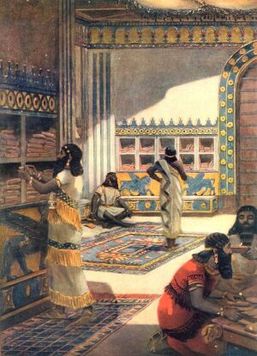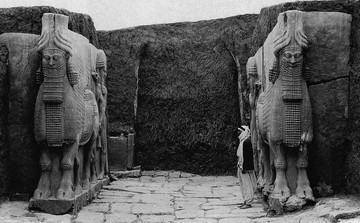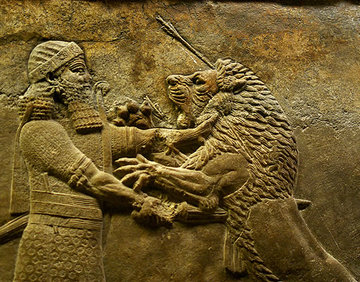Mesopotamia Daily Life in Assyria

Essential Themes
3. Government: How do humans organize their societies, and why do they organize them the way they do?
5. Conflict & Cooperation: How has warfare shaped human history?
7. Culture: How do we know what we know about human history?
The Assyrians
There were three major civilizations in ancient Mesopotamia. The first civilization was ancient Sumer. About a thousand years later, first the Babylonians and then the Assyrians took over, but the Sumerian culture lived on. The Babylonians lived in lower Mesopotamia. The Assyrians lived at the same time as the Babylonians, but the Assyrians lived at the foot of the Taurus mountains in northern Mesopotamia. The Assyrians had their own language and their own lifestyle. Their religion was similar to that of Sumer, and then Babylonia, and they worshiped many of the same gods. Because they were well known traders, their donkeys and caravans were known throughout Mesopotamia.
3. Government: How do humans organize their societies, and why do they organize them the way they do?
5. Conflict & Cooperation: How has warfare shaped human history?
7. Culture: How do we know what we know about human history?
The Assyrians
There were three major civilizations in ancient Mesopotamia. The first civilization was ancient Sumer. About a thousand years later, first the Babylonians and then the Assyrians took over, but the Sumerian culture lived on. The Babylonians lived in lower Mesopotamia. The Assyrians lived at the same time as the Babylonians, but the Assyrians lived at the foot of the Taurus mountains in northern Mesopotamia. The Assyrians had their own language and their own lifestyle. Their religion was similar to that of Sumer, and then Babylonia, and they worshiped many of the same gods. Because they were well known traders, their donkeys and caravans were known throughout Mesopotamia.
How did the Assyrians rise to power?
 CLICK above to learn more about Assyrian warfare.
CLICK above to learn more about Assyrian warfare.
Through military domination, the Assyrians conquered many lands and built a huge empire that included Babylon, Syria, Palestine, and even Egypt. Assyrians were cruel to the people they captured. Enemies who surrendered were allowed to choose a leader. However, those who refused to submit were captured and made slaves or were killed.
In order to control an empire as large as theirs, the Assyrians needed a well organized system of government. The Assyrians governed their conquered lands by allowing defeated peoples to be ruled by a local leader or king. The local leader would rule under the direction of the Assyrians and would send tribute to the Assyrian emperor. That meant that the ruler had to pay for the protection given by the Assyrian army. In other words, a tribute was a sort of tax paid to the Assyrians.
Military Camp: The Assyrians were forever at war with somebody, and it was through war that the Assyrian empire grew. That was expensive. As a result, taxes were terrible in ancient Assyria. But their geographic expansion was impressive and, due to that expansion, the Assyrians also advanced quickly in art and sculpture. The Assyrians used art to tell their stories of battles and to honor their war heroes.
In order to control an empire as large as theirs, the Assyrians needed a well organized system of government. The Assyrians governed their conquered lands by allowing defeated peoples to be ruled by a local leader or king. The local leader would rule under the direction of the Assyrians and would send tribute to the Assyrian emperor. That meant that the ruler had to pay for the protection given by the Assyrian army. In other words, a tribute was a sort of tax paid to the Assyrians.
Military Camp: The Assyrians were forever at war with somebody, and it was through war that the Assyrian empire grew. That was expensive. As a result, taxes were terrible in ancient Assyria. But their geographic expansion was impressive and, due to that expansion, the Assyrians also advanced quickly in art and sculpture. The Assyrians used art to tell their stories of battles and to honor their war heroes.
The Assyrians were military masters. Their use of the chariot and siege engines changed how battles were fought.

Because so many of the scenes painted on their ceramics and carved in stone show pictures of military life, we know a lot about daily life in the military camps. Many pieces of art picture a royal canopy in the center of the military camp. The king’s face is usually shown. The chariot of the time was mounted on six wheels.
Much of the art shows scenes from the battlefield and are quite detailed. From the art it's clear what each soldier packed and wore to battle. Included in each soldier's kit was an inflatable bladder to aid the crossing of rivers. Other military art shows more mundane activities. Some art features a camp bakery or soldiers at meals. Others show a servant holding a scoop from which a soldier is taking a drink. A lot of the art features horses and grooms. And some art shows men guarding the entrance to the camp wearing sandals and carrying shields.
Much of the art shows scenes from the battlefield and are quite detailed. From the art it's clear what each soldier packed and wore to battle. Included in each soldier's kit was an inflatable bladder to aid the crossing of rivers. Other military art shows more mundane activities. Some art features a camp bakery or soldiers at meals. Others show a servant holding a scoop from which a soldier is taking a drink. A lot of the art features horses and grooms. And some art shows men guarding the entrance to the camp wearing sandals and carrying shields.
Burial Ceremonies: Ceremonies changed over the many thousands of years that this civilization flourished. Bodies were put to rest in cemeteries, and in jars with tight lids, or the deceased were buried in the desert.
The ancient Mesopotamians did not believe in a happy, busy afterlife. In the funeral ceremony itself, they would place the hand of the deceased on a plate of food, so that the dead would have something for the trip to the after-world. They would bury their dead with a few of their favorite possessions - weapons, favorite drinking cups, and other small personal items.
The Assyrians, however, handled burial differently. They liked to keep their dead at home. The poor would dig a hole somewhere in the house and bury their dead. The rich would build a room just for the burial. In both cases, an oil lamp would be kept burning near or at the grave site. The lantern reminded everyone that the deceased was near and well-cared for.
The ancient Mesopotamians did not believe in a happy, busy afterlife. In the funeral ceremony itself, they would place the hand of the deceased on a plate of food, so that the dead would have something for the trip to the after-world. They would bury their dead with a few of their favorite possessions - weapons, favorite drinking cups, and other small personal items.
The Assyrians, however, handled burial differently. They liked to keep their dead at home. The poor would dig a hole somewhere in the house and bury their dead. The rich would build a room just for the burial. In both cases, an oil lamp would be kept burning near or at the grave site. The lantern reminded everyone that the deceased was near and well-cared for.
|
Buildings: The Assyrians constructed enormous public buildings. As a way to protect the building from evil influences, they loved to decorate them with huge demons. Among the most elaborate buildings were the palaces of the Assyrian kings. Every detail about the King's palace announced the power of the King. Entries were guarded by large creatures that combined the bodies of mythical creatures with the head of the king. Palace walls displayed people bringing tribute to the king, as well as depictions of the kings conquests, both on the battle field and during the hunt.
Why do you think the Assyrians hated Babylon so much?
The Assyrians sack Babylon! About 1200 BCE, the Assyrians finally conquered Babylon. This was a total shock to the people of the time, probably even a shock to the Assyrians. Babylon was the prize - the greatest city of the time. The Assyrians hated the Babylonians. When the Assyrians defeated the Baylonians, they leveled the city, turning it into rubble.
As was their habit, they made all the people in Babylonia move to other parts of the Assyrian Empire. When they conquered someone, the Assyrians made the conquered people move. That way, the people had to learn new ways of doing things in a new place. As a result, the conquered people were much less likely to revolt as a group. In effect, they were no longer part of a group. After they leveled Babylon, the Assyrians began to worry. They were not worried about the people they had scattered all over their empire. They were worried about Marduk, Chief of all the gods. After thinking it over, it occurred to them that Marduk might be a bit upset with them for leveling his city. They were afraid Marduk might punish them. |
|

The Assyrians decided the smartest thing to do would be to rebuild the city, and to return the statue of Marduk to his temple. They really did not have any use for the city. And they really hated the Babylonians and everything they built, especially Babylon. But, they were more afraid of the god Marduk than they were filled with hate for the Babylonians. So, they rebuilt Babylon, but let it stand as an empty city. Eventually, however, people returned to the city and Babylon rose again.
How do we know so much about ancient Babylon and Assyria?
The Great Library of Nineveh: The Assyrian Empire lasted for about 600 years. Around 600 BCE, before the people of ancient Mesopotamia were absorbed into the great Persian Empire, the last Assyrian king, Ashurbanipal, started a project. In his capital city of Nineveh, he began collecting a library of clay tablets. Ashurbanipal wanted his library to consist of all the literature of ancient Sumer, Babylonia, and Assyria.
No one knows how many tablets Ashurbanipal actually collected but, when discovered in modern times, over 30,000 tablets still remained in the great library. These tablets are our single most important source of knowledge about ancient Mesopotamia.
How do we know so much about ancient Babylon and Assyria?
The Great Library of Nineveh: The Assyrian Empire lasted for about 600 years. Around 600 BCE, before the people of ancient Mesopotamia were absorbed into the great Persian Empire, the last Assyrian king, Ashurbanipal, started a project. In his capital city of Nineveh, he began collecting a library of clay tablets. Ashurbanipal wanted his library to consist of all the literature of ancient Sumer, Babylonia, and Assyria.
No one knows how many tablets Ashurbanipal actually collected but, when discovered in modern times, over 30,000 tablets still remained in the great library. These tablets are our single most important source of knowledge about ancient Mesopotamia.






